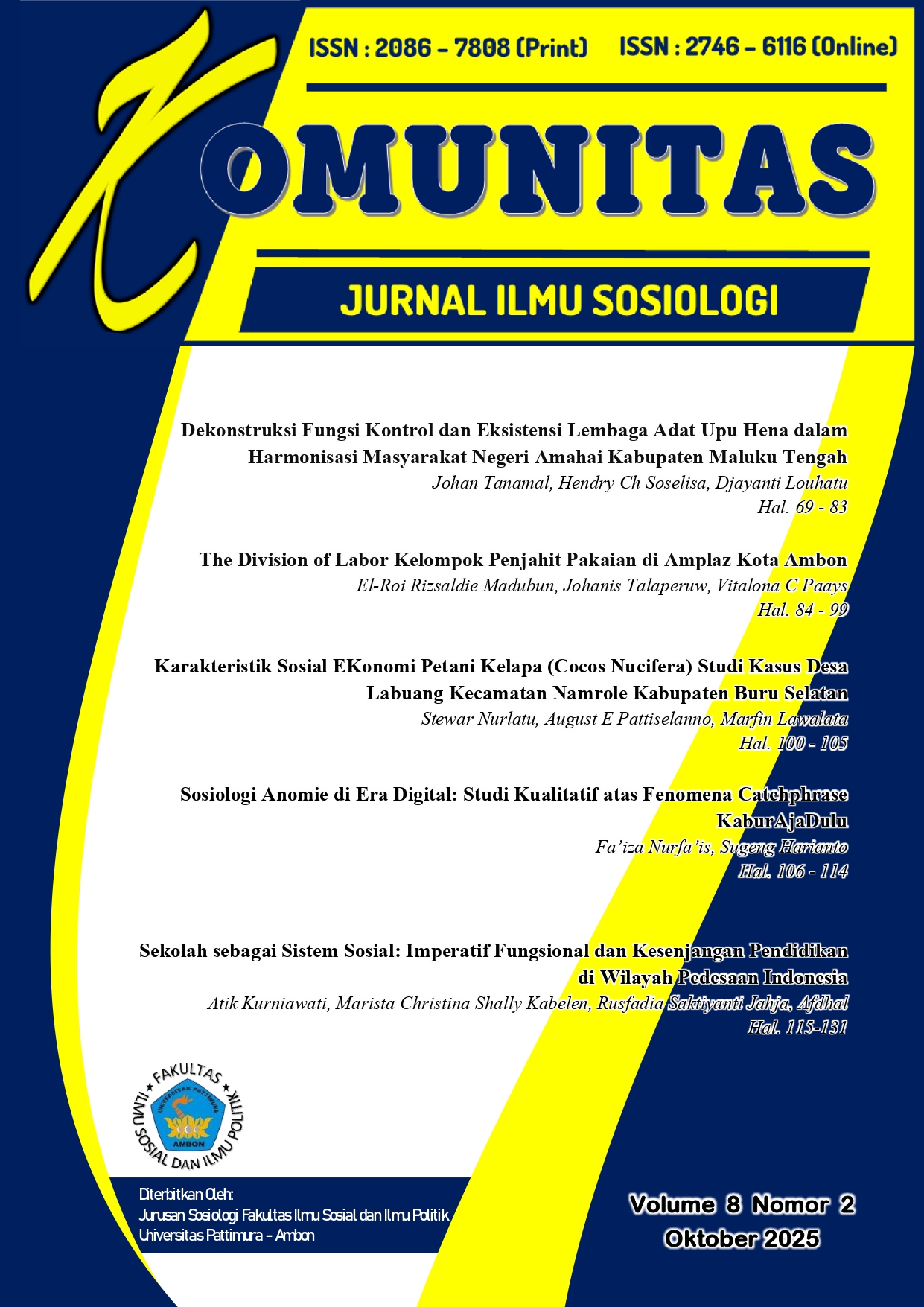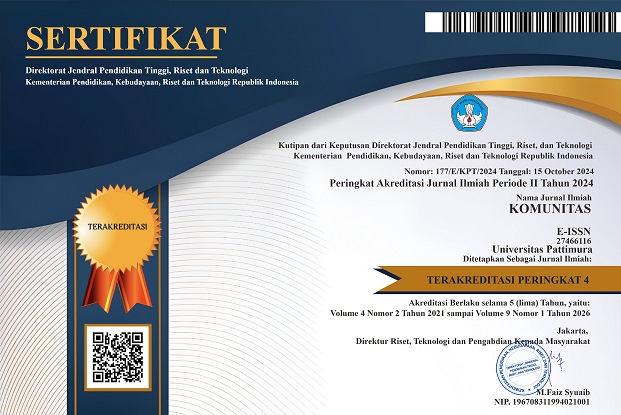The Division of Labor: Kelompok Penjahit Pakaian di Amplaz Kota Ambon
Abstract
This study examines the division of labor system used by the clothing tailor group in Amplaz, Ambon City. This study uses qualitative research methods to explain the division of labor in the clothing tailor group in Amplaz. The results of the study found that the division of labor in the tailor group is based on the specialization of sewing skills possessed by the tailors. In the sewing business premises in the Amplaz building, there are sewing businesses owned by the business owner who employs several tailors as employees, and there are also businesses owned by the tailors themselves or private businesses. The clothing tailor group is divided into two: a group of tailors who work for the business owner, and a group of tailors who have their own business. The two groups of tailors have different division of labor systems in the tailor group based on the specialization of sewing skills possessed by the tailors. The division of labor based on the specialization of skills possessed can give rise to solidarity based on dependence on skills to gain profit. This solidarity is rational because it is based on the same goal of gaining profit. The division of labor creates solidarity that can create trust, networks, and norms within the tailor group.
Downloads
References
Agusyanto. Ruddy, 2007. “Jaringan Sosial Dalam Organisasi” Jakarta: PT RajaGrafindo Persada.
Benkler, Y. (2006). The wealth of networks: How social production transforms markets and freedom. New Haven, CT: Yale University Press
Chaudhary, A. K. (2023). Social capital and the role of the state: Nurturing collectives for poverty alleviation. Social Philosophy and Policy. https://doi.org/10.1017/S1477175623000245
Claridge, T. (2018). Functions of social capital – Bonding, bridging, linking. Social Capital Research (Report). https://doi.org/10.5281/zenodo.7993853
Doyle Paul Johnson. “Teori Sosiologi Klasik dan Modern” Jilid 1.Terje. Robert Lawang. Jakarta: PT Gramedia, 1986.
Durkheim, Emile. 1964a: “The Division of Labour in Society”. New York: The Free Press. .PDF. sites.middlebury.edu/individualandthesociety/.../division-of-labour
Field, John, 2010. “Modal Sosial”. Terj. Nurhadi, KREASI WACANA, Bantul.
Gannon, B., & Roberts, J. (2018). Social capital: Exploring the theory and empirical divide. Empirical Economics, 54(4), 1110–1135. https://doi.org/10.1007/s00181-018-1556-y
Hapsari, Sri Dewi, 2021. “Kegiatan Wirausaha Penjahit Pakaian Di Desa Bungin Kecamatan Banua Lawas Kabupaten Tabalong”. JTAMPS: Jurna Tugas Akhir Pendidikan Sosiologi, Vol.1 No.1 April 2021.
Lawang. Robert M.Z, 2004. Kapital Sosial Dalam Perspektif Sosiologik – Suatu Pengantar Jakarta: FISIP UI Press, Fakultas Ilmu Sosial dan Ilmu Politik Universitas Indonesia.
Miles,Matthew,Huberman,Michael, 2009.“Analisis Data Kualitatif Buku Sumber Tentang Metode-Metode Baru”. Terj. Tjetjep Rohendi Rohidi, UI Press. Jakarta.
Moleong, J. Lexy (2007) Metodologi Penelitian Kualitatif PT Rosdakarya,Bandung.
Muslimah, 2020. “Pengaruh Usaha (Taylor) Penjahit Pakaian Terhadap Penigkatan Pendapatan Keluarga Di Desa Jaddih Kecamatan Socah Kabupaten Bangkalan”. Program Studi Ekonomi Syariah Sekolah Tinggi Agama Islam Darul Hikmah, Bangkalan.
Myeong, S. (2016). Which type of social capital matters for building trust in government? Sustainability, 8(4), 322. https://doi.org/10.3390/su8040322
Ritzer, George, “Teori Sosiologi Modern” Edisi Pertama.Jakarta.: KENCANA Prenada Media Group, 1995.
Samuel. Hanneman, 2010. Emile Durkheim Riwayat, Pemikiran, dan Warisan Bapak Sosiologi Modern, Depok: Penerbit Buku Kepik Ungu, LabSosio UI dan PT Global Sosiatama.
Sevcenko, V. (2022). Surplus division between labor and capital. Academy of Management Annals, 16(1), 74–101. https://doi.org/10.5465/annals.2019.0130
Sokanto, Soerjono “Sosiologi – Suatu Pengantar”. Jakarta PT RajaGrafindo Persada, 2006.
Taborsky, M. (2025). Division of labour as a key driver of social evolution. Philosophical Transactions of the Royal Society B, 380(1985), 20240234. https://doi.org/10.1098/rstb.2024.0234
van Bakel, M., & Horak, S. (2024). Social Capital Theory. In K. Hutchings, S. Michailova, & A. Wilkinson (Eds.), A Guide to Key Theories for Human Resource Management Research (pp. 261–267). Cheltenham, UK: Edward Elgar. https://doi.org/10.4337/9781035308767.ch33
Weiler, M. (2024). Can we measure the structural dimension of social capital? Journal of Institutional Economics, 20(2), 145–168. https://doi.org/10.1017/S174413742300045X
Copyright (c) 2025 El-Roi Rizsaldie Madubun, Johanis Talaperuw, Vitalona Crysantini Paays

This work is licensed under a Creative Commons Attribution-NonCommercial-ShareAlike 4.0 International License.


2.png)










.png)

